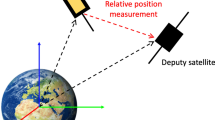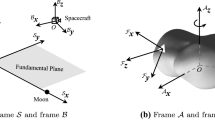Abstract
An integrated strategy is proposed for asteroid orbiting, consisting of stationkeeping, autonomous navigation, and real-time geodetical recovery. It is designed to maintain the spacecraft on its nominal trajectory under some uncertainties from the spacecraft and the asteroid. Furthermore, it performs adaptive estimations on the mass and thruster of spacecraft, as well as the spherical harmonic coefficients and spin rate of the gravity field of asteroid. These estimations are then substituted into an extended Kalman filter for autonomous navigation, which has significantly reduced positioning errors. Inheriting the original idea of sliding mode control, the integrated strategy is designed to be adaptive and robust with control saturation. The accuracy and distribution of real-time geodetical recovery of Lutetia’s gravity fields are investigated by Monte Carlo simulations. Numerical simulations show that the proposed strategy can rapidly decrease the control errors and accurately estimate the aforementioned parameters.








Similar content being viewed by others
References
Gradie, J., Tedesco, E.: Compositional structure of the asteroid belt. Science 216(4553), 1405–1407 (1982). https://doi.org/10.1126/science.216.4553.1405
Zellner, B., Tholen, D.J., Tedesco, E.F.: The eight-color asteroid survey: results for 589 minor planets. Icarus 61(3), 355–416 (1985). https://doi.org/10.1016/0019-1035(85)90133-2
Tonry, J.L.: An early warning system for asteroid impact. Publ. Astron. Soc. Pac. 123(899), 58–73 (2010). https://doi.org/10.1086/657997
Sonter, M.J.: The technical and economic feasibility of mining the near-earth asteroids. Acta Astronaut. 41(4–10), 637–647 (1997). https://doi.org/10.1016/S0094-5765(98)00087-3
Hein, A.M., Matheson, R., Fries, D.: A techno-economic analysis of asteroid mining. Acta Astronaut. 168, 104–115 (2020). https://doi.org/10.1016/j.actaastro.2019.05.009
Scheeres, D.J.: Stability of hovering orbits around small bodies. Adv. Astronaut. Sci. 102, 855–873 (1999)
Sawai, S., Scheeres, D.J., Broschart, S.B.: Control of hovering spacecraft using altimetry. J. Guid. Control Dyn. 25(4), 786–795 (2002). https://doi.org/10.2514/2.4947
Broschart, S.B., Scheeres, D.J.: Control of hovering spacecraft near small bodies: application to asteroid 25143 Itokawa. J. Guid. Control Dyn. 28(2), 343–354 (2005). https://doi.org/10.2514/1.3890
Reyhanoglu, M., Kamran, N.N., Takahiro, K.: Orbital and attitude control of a spacecraft around an asteroid. In: 12th International Conference on Control, Automation and Systems, Jeju Island, South Korea, pp. 1627–1632. IEEE (2012)
Guelman, M.: Closed-loop control of close orbits around asteroids. J. Guid. Control Dyn. 38(5), 854–860 (2015). https://doi.org/10.2514/1.G000158
Feng, J., Noomen, R., Yuan, J.: Orbital motion in the vicinity of the non-collinear equilibrium points of a contact binary asteroid. Planet. Space Sci. 117, 1–14 (2015). https://doi.org/10.1016/j.pss.2015.04.008
Liang, Y., Xu, M., Xu, S.: Bounded motions near contact binary asteroids by hamiltonian structure-preserving control. J. Guid. Control Dyn. 41(2), 401–416 (2018). https://doi.org/10.2514/1.G002528
Zhang, B., Cai, Y.: Twistor-based pose control for asteroid landing with path constraints. Nonlinear Dyn. 100(3), 2427–2448 (2020). https://doi.org/10.1007/s11071-020-05610-w
Takei, Y., Saiki, T., Yamamoto, Y., Mimasu, Y., Takeuchi, H., Ikeda, H., Ogawa, N., Terui, F., Ono, G., Yoshikawa, K., Takahashi, T., Sawada, H., Hirose, C., Kikuchi, S., Fujii, A., Iwata, T., Nakazawa, S., Hayakawa, M., Tsukizaki, R., Tanaka, S., Matsushita, M., Mori, O., Koda, D., Shimada, T., Ozaki, M., Abe, M., Hosoda, S., Okada, T., Yano, H., Kato, T., Yasuda, S., Matsushima, K., Masuda, T., Yoshikawa, M., Tsuda, Y.: Hayabusa2’s station-keeping operation in the proximity of the asteroid Ryugu. Astrodynamics 4(4), 349–375 (2020). https://doi.org/10.1007/s42064-020-0083-8
Xu, M., Xu, S.: Study on stationkeeping for halo orbits at EL1: Dynamics modeling and controller designing. Trans. Jpn. Soc. Aeronaut. Space Sci. 55(5), 274–285 (2012). https://doi.org/10.2322/tjsass.55.274
Gui, H., Vukovich, G.: Dual-quaternion-based adaptive motion tracking of spacecraft with reduced control effort. Nonlinear Dyn. 83(1–2), 597–614 (2016). https://doi.org/10.1007/s11071-015-2350-4
Lee, D., Vukovich, G.: Adaptive sliding mode control for spacecraft body-fixed hovering in the proximity of an asteroid. Aerosp. Sci. Technol. 46, 471–483 (2015). https://doi.org/10.1016/j.ast.2015.09.001
Zhang, B., Cai, Y., Li, F.: Adaptive double-saturated control for hovering over an asteroid. Adv. Space Res. 63(7), 2035–2051 (2019). https://doi.org/10.1016/j.asr.2018.12.017
Lee, K.W., Singh, S.N.: Immersion-and invariance-based adaptive control of asteroid-orbiting and-hovering spacecraft. J. Astronaut. Sci. 66(4), 537–553 (2019). https://doi.org/10.1007/s40295-019-00163-6
Xia, K., Zou, Y.: Adaptive fixed-time fault-tolerant control for noncooperative spacecraft proximity using relative motion information. Nonlinear Dyn. 100(3), 2521–2535 (2020). https://doi.org/10.1007/s11071-020-05634-2
Bhaskaran, S.: Autonomous navigation for deep space missions. In: 12th International Conference on Space Operations, Stockholm, Sweden (2012). https://doi.org/10.2514/6.2012-1267135
Miller, J.K., Konopliv, A.S., Antreasian, P.G., Bordi, J.J., Chesley, S., Helfrich, C.E., Owen, W.M., Wang, T.C., Williams, B.G., Yeomans, D.K.: Determination of shape, gravity, and rotational state of asteroid 433 Eros. Icarus 155(1), 3–17 (2002). https://doi.org/10.1006/icar.2001.6753
Konopliv, A.S., Park, R.S., Vaughan, A.T., Bills, B.G., Asmar, S.W., Ermakov, A.I., Rambaux, N., Raymond, C.A., Castillo-Rogez, J.C., Russell, C.T., Smith, D.E., Zuber, M.T.: The Ceres gravity field, spin pole, rotation period and orbit from the dawn radiometric tracking and optical data. Icarus 299, 411–429 (2018). https://doi.org/10.1016/j.icarus.2017.08.005
Pätzold, M., Andert, T.P., Asmar, S.W., Anderson, J.D., Barriot, J.P., Bird, M.K., Häusler, B., Hahn, M., Tellmann, S., Sierks, H., Lamy, P., Weiss, B.P.: Asteroid 21 Lutetia: low mass, high density. Science 334(6055), 491–492 (2011). https://doi.org/10.1126/science.1209389
Coradini, A., Capaccioni, F., Erard, S., Arnold, G., De Sanctis, M.C., Filacchione, G., Tosi, F., Barucci, M.A., Capria, M.T., Ammannito, E., Grassi, D., Piccioni, G., Giuppi, S., Bellucci, G., Benkhoff, J., Bibring, J.P., Blanco, A., Blecka, M., Bockelee-Morvan, D., Carraro, F., Carlson, R., Carsenty, U., Cerroni, P., Colangeli, L., Combes, M., Combi, M., Crovisier, J., Drossart, P., Encrenaz, E.T., Federico, C., Fink, U., Fonti, S., Giacomini, L., Ip, W.H., Jaumann, R., Kuehrt, E., Langevin, Y., Magni, G., McCord, T., Mennella, V., Mottola, S., Neukum, G., Orofino, V., Palumbo, P., Schade, U., Schmitt, B., Taylor, F., Tiphene, D., Tozzi, G.: The surface composition and temperature of asteroid 21 Lutetia as observed by Rosetta/VIRTIS. Science 334(6055), 492–494 (2011). https://doi.org/10.1126/science.1204062
Aljbaae, S., Chanut, T.G.G., Carruba, V., Souchay, J., Prado, A.F.B.A., Amarante, A.: The dynamical environment of asteroid 21 Lutetia according to different internal models. MNRAS 464(3), 3552–3560 (2017). https://doi.org/10.1093/mnras/stw2619
Carry, B., Kaasalainen, M., Leyrat, C., Merline, W.J., Drummond, J.D., Conrad, A., Weaver, H.A., Tamblyn, P.M., Chapman, C.R., Dumas, C.: Physical properties of the esa rosetta target asteroid (21) Lutetia-II. Shape and flyby geometry. Astron. Astrophys. 523, A94 (2010). https://doi.org/10.1051/0004-6361/201015074
Li, X., Qiao, D., Li, P.: Frozen orbit design and maintenance with an application to small body exploration. Aerosp. Sci. Technol. 92, 170–180 (2019). https://doi.org/10.1016/j.ast.2019.05.062
Acknowledgements
This work was supported by the National Natural Science Foundation of China (11772024).
Author information
Authors and Affiliations
Corresponding author
Ethics declarations
Conflict of interest
The authors declare that they have no conflict of interest.
Additional information
Publisher's Note
Springer Nature remains neutral with regard to jurisdictional claims in published maps and institutional affiliations.
Rights and permissions
About this article
Cite this article
Feng, Z., Zheng, Y. & Xu, M. Integrated strategy of stationkeeping, autonomous navigation, and real-time geodetical recovery of gravity fields: application into asteroid Lutetia mission. Nonlinear Dyn 106, 3247–3263 (2021). https://doi.org/10.1007/s11071-021-06694-8
Received:
Accepted:
Published:
Issue Date:
DOI: https://doi.org/10.1007/s11071-021-06694-8




